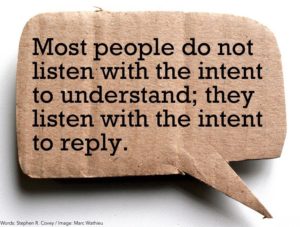 It’s absolutely true, listening is an art. And sadly, it has become a lost art. Few actually do it well. It would seem to be a pretty simple concept, but there are several deterrents that get in the way.
It’s absolutely true, listening is an art. And sadly, it has become a lost art. Few actually do it well. It would seem to be a pretty simple concept, but there are several deterrents that get in the way.
Many of us are guilty of starting a conversation and putting a thought or question out there. Instead of giving the other individual time to formulate a response, we immediately re-phrase the question or remark and answer it ourselves. In other words, we don’t give ourselves a chance to listen since we never stop talking.
The second reason is that even when we stop and wait for a response from the other person, we often don’t hear, or worse, comprehend, what they say because we are so busy formulating our reply to what we assume they will say. We want to be perceived as quick witted and always prepared with a snappy comeback to any question or comment. The problem with all of this is that we are missing so much vital and crucial information.
I make my living organizing and producing corporate conferences and special events. My clients are usually executives who understand the value of gathering a group of customers and holding their attention for two or three days with a packed meeting agenda during the day and entertainment in the form of receptions and dinners during the evenings. These corporate undertakings are detail heavy and typically not inexpensive. However the cost can merit exponential returns when meticulously planned and well crafted and that’s where I come in.
When a client calls and tells me they want to discuss a new project, I listen. I want to hear every word, pick up on each nuance, and watch their non-verbal body language. When a person is excited to share information, or tell you a very key point, they intuitively lean forward as if to say, “don’t miss this next point because it is very important”. So I remain quiet to hear every word, notice the inflection of their voice, whether they raise or lower the volume and the tone they use and watch for non-verbal hints.
People ask me all the time what I attribute to creating a successful meeting and my answer, without a doubt, is to be a good listener. Hear what your client tells you, and how many times and ways they tell you the same thing. When they mention a particular element, such as the need for a timely and topical speaker or opening the conference with a themed party that will set the mood and tone, then I take note. It tells me what the core component needs to be and allows me to build and frame the other aspects of the meeting to correlate and coordinate from that point.
Here’s my last tip to share about listening. Count to eight before you reciprocate. I have been guilty of hi-jacking a conversation and realizing that I spoke too soon and cut off the other individual’s response. It will seem like an eternity, but be smart and give the person with whom you are communicating the time to acknowledge your comment or statement. It builds respect and credibility. Not only does this expand the opportunities for communication, but you also allow yourself time to hear and take notice of their cerebral nuances.
Happy listening. You’ll be surprised what you hear!
 JESSEL HR CONSULT HR and Consulting Agency.
JESSEL HR CONSULT HR and Consulting Agency.




